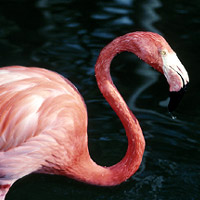Birds - American Flamingo
 Region:
Americas Region:
Americas
Class: Aves
Order: Phoenicopteriformes
Family: Phoenicopteridae
Genus: Phoenicopterus
Scientific Name: Phoenicopterus ruber ruber
Description: Length: 1.7 m. Females are smaller. Sexes
are similar. Both legs and neck are long and slender.
The beak is large with a downward bend and is specialized
for filter feeding.
Distribution: Atlantic coast of subtropical and tropical
America, locally Bahamas, Cuba, Hispaniola, Yucatan and
Guiana
Habitat: Brackish water of salt lakes and lagoons.
Food: Chiefly blue-green algae and diatoms
Skin/Color/Coat: Legs and feet are pink. Fore part of
the face is bare and grey in colour. Plumage entirely
pink and of various shades.
Vocalization: Flamingoes make a variety of loud honks
and high squeaks.
Reproduction and Development: Nests are usually made of
mud which is raked up by the bird with its bill into the
form of truncated cone from 15-30 cm high, with a shallow
depression on top. Nests are built in shallow water or
on open expanses of wet mud, but occasionally it builds
on the dry mud flats or even on small, rocky islands on
lagoons. In this case, the nest may consist of only a
small mound of grasses and gravel or a depression surrounded
by a low parapet of clay pellets formed by the bird. Normally,
one egg is laid, rarely two. Incubation is shared by male
and female and lasts 30-32 days. Until its bill has developed
the characteristic shape, a young flamingo is unable to
feed itself and relies on its parents. To feed a chick,
a parent stands behind it and lowers its neck so the chick
may take the tip of the parents bill into its own. The
adult regurgitates liquified food which runs down the
chick's throat. The parents seems to be able to recognize
their own chicks even when they are amongst a dense crowd
of other chicks. These crowds are always accompanied by
adults that can lead them away from danger.
Adaptations: Highly gregarious, nesting colonies often
contain thousands of pairs. Flamingos extract their food
from the water by a filtering mechanism, very much like
that used by the Blue Whale. They wade through the water
with necks lowered and heads turned upside down, sweeping
from side to side. The upper and lower portions of the
bill are fringed with bristles which trap particles as
the flamingo sucks and expells water with the powerful
tongue acting as a pump. The outer layer of coarse bristles
keeps out large particles, while minute algae such as
the diatoms are collected on an array of bristles inside
the bill.
Threats: Eagles may pick up young flamingos for food.
The main human menace to them is the destruction of their
coastal habitat and nesting sites by "development".
Status: Common |
|
|
